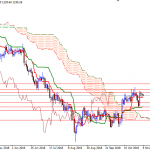We can see by the latest reading on the FRED chart that the velocity of money continues to decline. Even with Trump’s reflation, we only had a sliver of an uptick in the third quarter of 2017 from 1.425 to 1.427. But the chart still looks dismal:
Dr Edward Lambert of Effective Demand Research has an answer for those crying inflation in a response to a question on his article comments:
… If money supply times velocity matches growth in employment, there would be no inflation. But it seems that M*V not only matches growth in employed but doubles it. The only answer I can think of is that M*V is measured upon number of employed, and capacity building. Labor wages are stagnant. Supply-side is optimized and maximized. Inflation is muted to the point that it equals increases in employed people.Before 1980’s, there was surging demand from boomers and labor power. This was happening upon big increases in the number of employed. Labor had a lot of power back then. But now less people are building the employed numbers, they have less power.Demand is muted.The fact that less people are increasing the employed numbers may explain part of why velocity of money keeps falling, which keeps inflation in line with growth in employed.Edward
So, to summarize:
1. Wages are stagnant.
2. Supply side is optimized and maximized.
3. Inflation is muted.
4. Labor is not surging, but is weak.
5. Demand is muted.
6. Slow labor growth results in the decline of velocity, which is what is keeping inflation in line with growth in employment.
Perhaps those 15 million people permanently missing from the labor force, from the writings of Jeffrey P. Snider, have made it impossible for the Fed to create inflation. Labor growth must be much more robust for inflation to wake up from its deep sleep.
It is this truth about inflation that has so many people pining to create a real estate bubble. Anything to create jobs, and massive growth in jobs, is the driving logic behind people wanting to relax regulation in lending.














Leave A Comment